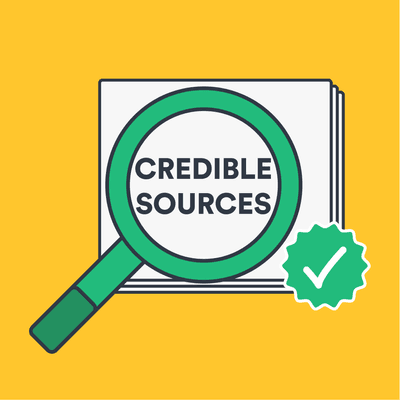What are Credible Sources?
February 16, 2023
In a world where so much information is thrown at us, how do we know what’s real and what’s not?
In a world where so many research papers are assigned, how do we know which sources are reliable and which are not?
What makes a source credible or reliable? Some items that can lend to the credibility of an article are:
- the education and credits of the author
- peer reviews
- unbiased information
- association with other sources and/or organizations, as well as citations
- recency and relevancy
To find out if a source is reliable, first look at who wrote it. Check if they have any certificates, degrees, or other experiences that qualify them to write this article. Many authors attach such information to their articles in a short biography. However, some authors and formats do not allow for this. If that is the case, then look them up online and check for the author’s achievements. If they do, then the source is more likely reliable than not. Someone certified in a topic is more likely to provide accurate information on that topic. If they have a degree in British Literature and have written an article about curing cancer, it’s not a good idea to use that article.
Peer reviews are often a positive sign of an article’s credibility. If an article is peer-reviewed, it means that other people certified in a certain topic have read, corrected, and reviewed the article. As this article has been reviewed by experts in the topic it covers, it is most likely safe to use. Additionally, a credible article will have the correct citations that lead to additional sources that prove the information’s accuracy.
When choosing an article to use research from, it should be read thoroughly. The overall quality of the article (think spelling, grammar, syntax, word choice, etc.) may point to its reliability. The reader should also have a firm understanding of if the information is biased or unbiased. According to the National Library of Medicine, biased research is a “systematic error introduced into sampling or testing by selecting or encouraging one outcome or answer over others.” Make sure that a potential source does not include any such information.
Before using a source, make sure it is up to date. Relevant research should not be from any source that has been published more than ten years prior. Information in articles published ten or more years ago can often be out of date and losing its relevancy.
Finding reliable sources can be difficult. Sites and locations that commonly provide reliable sources are academic aibraries and databases; government education websites, ending in .gov, .org, and .edu; sites from organizations that are devoted to research; and professional standards organizations.
One surefire way to find some reliable sources is to look for them using scholarly databases. Websites including, but not limited to: Ignite, Gale, and , which can be accessed from the SJHS Media Services Canvas page, have a number of peer-reviewed (as well as not) reliable articles and other sources of information and research.
Being able to recognize credible sources is an imperative skill for navigating everyday life, not just academic life. Rooting out misinformation and pseudo-research helps people live knowledgeable, truthful, and peaceful lives. Knowing what information is credible and what information is not is essential understanding the world.
Sources: https://www.ncbi.nlm.nih.gov/pmc/articles/PMC2917255/#:~:text=In%20research%2C%20bias%20occurs%20when,and%20publication%20(Figure%201).







